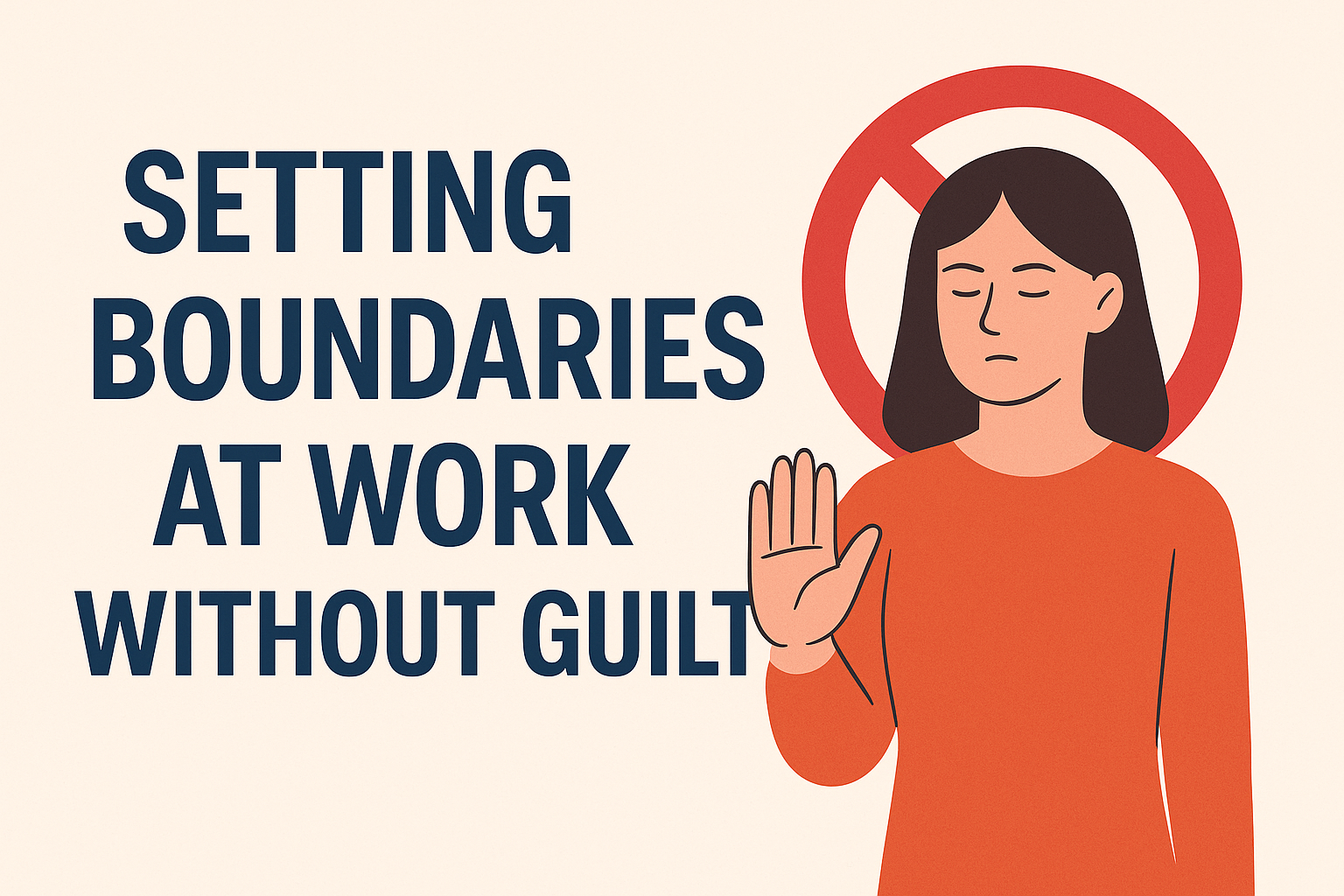Setting Boundaries at Work Without Guilt

You start your workday with good intentions—complete your to-do list, stay focused, and log off on time. But before you know it, you’ve said yes to three extra tasks, skipped lunch, responded to emails at 9 p.m., and now feel overwhelmed and drained.
Sound familiar?
In today’s hyper-connected, always-on work culture, setting boundaries isn’t selfish—it’s essential. Without them, burnout is inevitable, performance suffers, and job satisfaction drops.
In this guide, we’ll help you:
- Understand why boundaries matter
- Identify the boundaries you need
- Set them without damaging relationships
- Handle pushback and guilt
- Learn from a real-world example
Let’s get your energy, time, and sanity back—without compromising your professionalism or ambition.
1. Why Boundaries Are Critical at Work
✅ Prevent burnout and mental fatigue
✅ Improve productivity and focus
✅ Build respect from peers and leaders
✅ Enhance work-life balance and job satisfaction
According to Gallup, 76% of employees experience burnout sometimes or often—and a major contributor is the absence of healthy boundaries.
Fact: You can be ambitious and assertive without saying yes to everything.
2. What Kind of Boundaries Do You Need?
Think of boundaries in these key areas:
✅ Time boundaries – When you start/stop work, when you take breaks
✅ Communication boundaries – How and when you respond to messages
✅ Responsibility boundaries – What tasks are (and aren’t) yours
✅ Emotional boundaries – What behavior you accept or reject
Self-check: Where do you feel drained, resentful, or overwhelmed? That’s likely where a boundary is missing.
3. Common Boundary Mistakes (and How to Fix Them)
❌ Saying yes to everything = becoming a doormat
❌ Working beyond your limits = unsustainable
❌ Avoiding confrontation = quiet resentment
✅ Fix: Learn to say no with clarity, not conflict
✅ Fix: Define limits in advance so you're not reactive
✅ Fix: Communicate early and often—not only when you’re overwhelmed
Resource: How to Stand Out at Work (Without Burning Out)
4. How to Set Boundaries Professionally
Step-by-step:
- Identify the specific issue – “I’m working evenings to catch up on last-minute requests.”
- Decide your new boundary – “I’ll no longer respond to non-urgent messages after 6 p.m.”
- Communicate clearly and proactively –
“To stay focused and avoid burnout, I’m protecting time after 6 p.m. for rest. I’ll be sure to respond first thing in the morning.”
- Hold the line – Be consistent. Boundaries are built through behavior, not announcements.
Tool: Use Google Calendar to block “Deep Work” and “Log Off” hours.
5. Scripts for Common Workplace Scenarios
✅ Saying No to Extra Work
“I’d love to help, but I’m at capacity this week. Can we revisit next week or re-prioritize?”
✅ Preventing After-Hours Work
“To maintain my energy and productivity, I don’t check emails after hours. Let’s touch base first thing tomorrow.”
✅ Handling Interruptions During Focus Time
“I’m in deep work mode right now—can we reconnect in 30 minutes when I can give this my full attention?”
✅ Deflecting Emotional Dumping from Colleagues
“I care about what you’re going through, but I’m feeling overwhelmed myself. Maybe we can revisit this later or talk to [HR/Manager]?”
6. How to Handle Guilt or Pushback
Yes, some people may resist when you first set boundaries—especially if they’ve benefited from you not having them.
Here’s how to deal:
✅ Acknowledge your discomfort but hold the boundary
“It’s uncomfortable, but necessary for my wellbeing and performance.”
✅ Reframe boundaries as pro-team, not anti-team
“When I take proper breaks, I come back sharper and more helpful to the team.”
✅ Stay calm and repeat your limits
You don’t owe elaborate justifications. Short, clear, respectful replies are enough.
7. Tips for Remote and Hybrid Workers
Remote work has blurred the boundaries even more. Here’s how to reset:
✅ Set log-off rituals – Shut laptop, change clothes, go for a walk ✅ Turn off notifications after hours – Use tools like Slack’s Do Not Disturb ✅ Communicate availability clearly in team calendars or email footers ✅ Say no to “just one more quick thing” at 6:59 p.m.
8. Case Study: How Alina Took Back Control Without Losing Respect
Background: Alina, a senior analyst in London, had become the team’s unofficial helper. She stayed late, filled gaps, and responded to messages 24/7.
Impact:
- Felt resentful and underappreciated
- Started missing deadlines on her core work
- Mental exhaustion and poor sleep
What She Did:
- Met with her manager and said, “I want to sustain my performance, so I’m setting clearer work boundaries.”
- Created a working hours policy and shared it with her team
- Delayed responses to non-urgent pings after hours to train expectations
- Started saying no to extra requests outside her role
Results:
- Became more productive and creative
- Colleagues respected her time more
- Was promoted 3 months later for “strategic thinking and ownership”
Her takeaway: “I thought boundaries would make me look selfish. Instead, they made me look serious.”
9. Tools to Help You Hold Boundaries
✅ Clockify – Track work hours and spot overwork trends
✅ Freedom – Block distractions during deep work
✅ Calendly – Schedule meetings within working hours only
✅ RescueTime – Understand where your time goes each day
10. Final Thoughts: Boundaries Are Professional, Not Personal
Setting boundaries is not about withdrawing—it’s about leading yourself well so you can contribute sustainably.
When you:
- Get clear about what you need
- Communicate honestly and respectfully
- Follow through consistently
…you model leadership and build trust.
So next time you hesitate to say no or feel guilty for protecting your time, remember this:
Boundaries aren’t barriers—they’re bridges to better work and better wellbeing.

